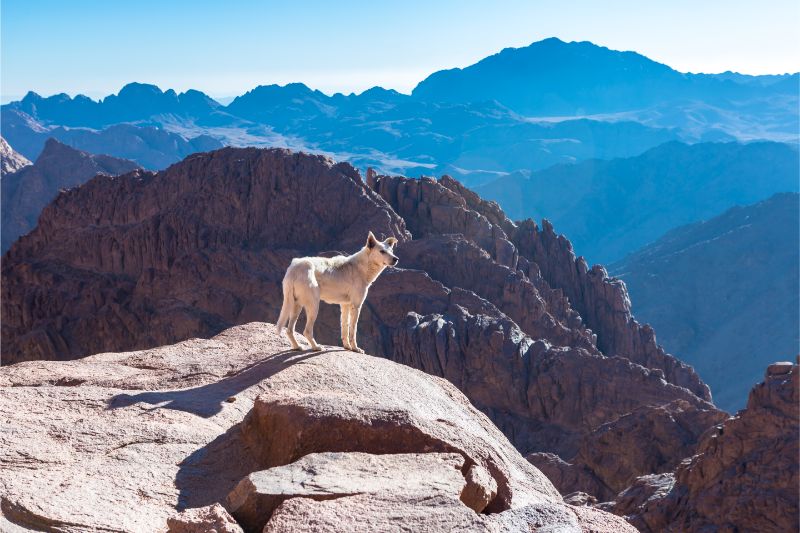Can Pets Get Altitude Sickness?

At our altitude of 5,280 feet above sea level, most Denver residents and visitors don’t experience the debilitating effects of altitude sickness. However, once they venture into the mountains, the situation changes. Nausea, dizziness, and shortness of breath associated with altitude sickness. This affects about 20% of people above 8,000 feet. Potentially ruining a day of skiing, hiking, or sightseeing.
Pets are also vulnerable to altitude changes and can experience many of the same symptoms as humans. Left unchecked, altitude sickness in pets can be dangerous. And can lead to a potentially deadly buildup of fluid in the lungs and brain.
There’s nothing wrong with enjoying the great Colorado outdoors with your pet. However, knowing the signs of altitude sickness in pets and when to seek help is crucial for keeping them safe in the mountains.
Know the Signs
Just like humans, pets can get altitude sickness. This occurs when the concentration of oxygen molecules in the air decreases with elevation gain. As a pet’s body tries to compensate for the reduced oxygen, the following symptoms may appear:
- Shortness of breath
- Vomiting/nausea
- Loss of appetite
- Increased heart rate
- Pale gums
- Swelling of face, limbs
- Excessive panting or drooling
- Bleeding from the nose
- Collapse
If your pet is showing any of these signs of altitude sickness, decrease its activity and offer water immediately. Get your pet to an elevation below 8,000 feet as soon as possible.
If symptoms don’t improve once your pet is at a lower elevation, seek medical attention immediately. If not promptly addressed, the symptoms of high altitude sickness can become life-threatening.
Preventing Altitude Sickness on Hikes
If you’re planning to take your dog on a hike to a higher altitude, it’s essential to have a plan in place to prevent the onset of altitude sickness. Start by ensuring that your dog is healthy enough for physical activity. Discuss any medical concerns with your veterinarian.
Here are some additional tips for ensuring safe and enjoyable hiking experiences with your dog:
- Be sure to gradually increase your dog’s exposure to higher altitudes by starting lower and taking short hikes at progressively higher elevations over the course of several weeks. If your dog is adjusting well, increase the distance in the same manner. Over time, a healthy dog’s body should be able to adapt to utilizing oxygen better as the concentrations in the air decrease with the elevation gains.
- Dehydration can happen quickly at high altitudes, so make sure your dog gets plenty of water. A good rule of thumb is: Every time you stop for a drink, your pet should drink water, too. Be sure to take more water than you think you’ll both need.
- Pack more of your dog’s food than you think you’ll need for the time you’ll be on the trail. It’s better to be over-prepared and not need the extra food than to need it and not have it.
- Always closely monitor your pet’s activity levels when above 8,000 feet and watch for any signs of altitude sickness.
Breed Specific Health Issues and Altitude Sickness
- Dogs with heart conditions or heart murmurs should NOT go on hikes in the mountains.
- Brachycephalic (short-nosed) breeds like boxers, pugs, Pekingese, and bulldogs should be closely monitored. These breeds are prone to breathing problems that can be worsened by higher altitudes.
- You should NEVER attempt a high altitude hike with any dog that has not been properly acclimated to elevations above 8,000 feet and higher. Many mountain trails will take you well above timberline to 11,000 – 12,000 feet, and hiking a fourteener means going up to and over 14,000 feet. Only healthy dogs that are well-trained and acclimated for these altitudes and long distances should be taken on these hikes.
Pet First Aid Kit
Take a first aid kit for both you and your dog and know how to use the items in them. We also recommend that you take along a dog carrying harness or emergency canine carrier, just in case your dog gets injured or becomes ill and needs to be carried off the mountain.
Sharing our mountain experiences with our pets is a wonderful way to spend time, grow as companions, and get fit. With the awareness that pets can and do experience the same effects of altitude sickness as we do, our hope is that you will utilize our tips to make your mountain adventures safer.
As always, your Lone Tree Veterinary Medical Center team is here for you and your pet, so don’t hesitate to contact us with any questions or concerns you have regarding your pet’s health and well-being.



